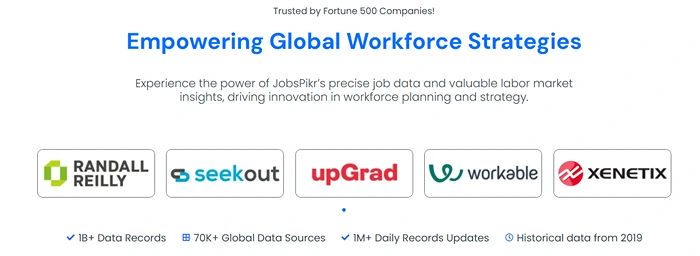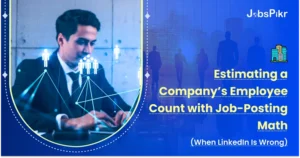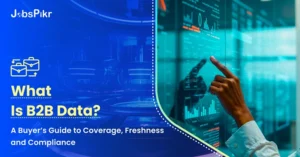- Why Companies Are Betting on AI Recruitment Data for Efficiency
- The Bias That Never Left Recruitment Data
- Privacy? What Does That Mean?
- GDPR and the Fight for Transparency in Recruitment Data
- So, How Do You Fix These Issues?
- A Real Company, A Real Story with Recruitment Data
- The Bigger Picture of Recruitment Data and Job Analytics
- Why Recruitment Data Needs a Human Touch
Let’s face it: hiring has never been simple. And today, it’s more complex—and more digitized—than ever before. The days of resumes being stacked on your desk or filling up your inbox are over and have been replaced by software that can parse, score, filter, and sort a plethora of resumes before a human even looks at them.
With AI rising in prominence, the results may not always be fair or 100% right. If you’ve used any AI tool, you’ll notice that its responses aren’t always accurate, and blind faith in such systems may create unintentional biases and blind spots.
Why Companies Are Betting on AI Recruitment Data for Efficiency

Image Source: People Managing People
Picture this: your company posts a job opening for a backend engineer. Within 48 hours, 500 resumes flood in. It’s a deluge. Manually reviewing them is not just daunting—it’s impractical. That’s where tools like HireEZ, Textio, or Beamery come in. They promise to surface the best candidates fast. And often, they do. Unilever cut screening time from weeks to days using similar tech.
These platforms aren’t just skimming resumes. They map skill relationships. If a candidate lists “JavaScript,” the system knows to look for React, Node.js, or TypeScript. That’s smart. But sometimes the tech is too clever. By over-prioritizing patterns, it may miss nuance—a self-taught developer, a career-switcher, or someone who just doesn’t optimize for keywords.
Even tools that analyze behavior—think Pymetrics with its gamified assessments—aim to predict traits like resilience or collaboration. But here’s the question: can a browser game really know if you’re a team player? Or are we just hoping it can?
Some recruiters buy into these tools without fully understanding how they work, chasing the illusion of objectivity. But there’s quite a difference between using a tool to assist in decision-making and letting it completely run the show.
The Bias That Never Left Recruitment Data
Bias in hiring didn’t disappear—it just got coded. Imagine a company that’s historically hired from the same three universities, favoring men in their twenties. Feed that recruitment data into an algorithm, and you get a model that replicates exactly that. Not because it’s malicious, but because it thinks that’s success.

Image Source: Vervoe
We’ve already seen it happen. Amazon’s 2018 hiring tool penalized resumes that included the word “women’s.” No one programmed it to do that—it learned from patterns. And when you teach a machine that certain candidates were “better,” it’s going to favor those attributes, even if they’re irrelevant or discriminatory.
Or consider location bias. A University of California study showed mortgage approval algorithms were less likely to greenlight applications from Black-majority neighborhoods. In hiring, the same logic can apply: ZIP codes become proxies for race or class. AI doesn’t know it’s discriminating—it’s just finding patterns.

Image Source: Logic Melon
Some tools even evaluate facial expressions and voice tone. HireVue once did. Studies showed they misinterpreted expressions in darker-skinned faces and regional accents. The intent wasn’t biased, but the outcome absolutely was.
And the most worrying part? You often can’t see how the decision was made. It’s a black box. Even the developers sometimes don’t know exactly why a candidate was rejected, and that makes matters worse.
But what’s detrimental is that people only realize this years or months later, when the damage is done and it’s even harder to rectify mistakes.
Privacy? What Does That Mean?
Here’s what most candidates don’t realize: applying for a job today might mean giving up far more than your resume. Some platforms scrape LinkedIn data, pull archived posts, analyze writing tone, and even assess video backgrounds, spotting everything from religious symbols to children’s toys.
You didn’t agree to that explicitly. But you probably clicked “accept” on a 15-page privacy policy you didn’t read. A Gartner study found that over 90% of job seekers never look at the terms. They assume the company will act ethically. That’s a big assumption.
And what about security? HR systems hold gold mines of personal info. The Kronos ransomware attack in 2022 exposed millions of employee records. And still, many companies don’t encrypt applicant data at rest. Worse, they store it indefinitely. That job you applied to in 2019? It’s likely still sitting in a cloud folder somewhere.
This isn’t just a nuisance—it’s a legal liability. Under regulations like the GDPR, keeping data “just in case” can get you fined. And rightly so.
There’s also the problem of consent theater—pretending someone has agreed to invasive practices when in fact they had no meaningful choice. It’s one thing to accept cookies; it’s another to unknowingly hand over biometric data.
GDPR and the Fight for Transparency in Recruitment Data
If there’s one piece of legislation that’s changed the privacy game, it’s GDPR. The General Data Protection Regulation is becoming the gold standard.
Under Article 22, candidates have the right to challenge any decision made solely by automated processing. That means if an AI filters you out before a human sees your resume, you can demand to know why—and ask for a real person to take a second look.
You also have the right to be forgotten. Want your data deleted from a company’s system? They have to comply. And if they’re collecting data they don’t need (say, GPA for a warehouse job), that’s a problem.
Employers can’t just outsource responsibility to vendors, either. If your AI partner messes up—if they leak data, introduce bias, or store info illegally—you’re still on the hook. It’s your process, your liability.
GDPR is just the start. Similar laws are emerging in the U.S., Canada, Brazil, and beyond. But legislation often lags behind the tech. Until then, ethics must lead.
So, How Do You Fix These Issues?

Image Source: AI transforming Jobfeed by JobsPikr
The good news? Ethical, responsible AI hiring is absolutely possible. But it takes work.
- Start with transparency. Let candidates know what tech you’re using and why. Offer opt-outs where possible. Use plain language—not legalese. Example: “We use an AI tool to help match skills to roles. It doesn’t assess your age, gender, or background. A human reviews every decision.”
- Next, blind your data. Strip resumes of names, photos, graduation dates, and anything else that could lead to bias. Focus on skills and experience. If orchestras can hire more fairly with blind auditions, surely hiring managers can do the same.
- Run audits. Regularly test your system. Feed in identical resumes with only one change—a name, a neighborhood, a college. If the results shift, your tool has a bias problem. Fix it. And don’t just do this once—bias can creep back in over time.
- Demand explainability. If your AI can’t explain why it rejected someone, don’t use it. Tools like IBM’s Fairness 360 and LIME can help decode opaque models.
And never let AI be the final word. Use it to narrow a list, maybe. But never to make the final call. People should hire people.
Also, don’t forget the importance of feedback loops. Let rejected candidates appeal decisions or ask for a second review. This isn’t just good ethics—it improves the system by catching false negatives.
A Real Company, A Real Story with Recruitment Data
Let’s say you run a 200-person tech startup. You’re hiring fast and drowning in resumes. You roll out an AI screener for junior engineering roles. It works well, sort of. Time-to-hire drops by a third. But then, something feels off. You notice very few women making it past the first round.
You pause. You look closer. Turns out, the AI weighed open-source contributions heavily—but only counted those hosted on GitHub. Many women in your applicant pool used alternative platforms or collaborated privately.
So you tweak the system. You adjust the weighting. You blind the resumes. You run new tests. Diversity ticks up. So does the quality of your hires. More importantly, trust builds—with candidates and your own team.
Now, you write a transparency statement and publish it on your careers page. You explain how AI is used, how often it’s audited, and what rights applicants have. You include a contact email for anyone who wants a human review.
And here’s the kicker: your employer brand improves. People talk. They share. They apply—not just because of the role, but because of how you hire.
You become known not just for what you build, but how you build your team.
The Bigger Picture of Recruitment Data and Job Analytics
We are living in an age where technology moves faster than ethics. AI can scan a thousand resumes in seconds—but it can also screen out a brilliant, nontraditional candidate without a trace. When done right, AI hiring can reduce human bias, save time, and expand opportunity. Done wrong, it reinforces inequality and damages trust.
If you’re considering moving onto a system that handles recruitment for you and screens resumes, ask yourself-
- Can you explain your hiring process clearly to a candidate?
- Do you know where your AI data comes from—and where it goes?
- Are you tracking the outcomes of your tools, not just their efficiency?
Why Recruitment Data Needs a Human Touch
AI in hiring isn’t going away. Nor should it. But if we want to build workplaces that are truly inclusive, innovative, and human-centered, we need to do better than hiding behind algorithms.
Hire slow when you must. Question fast. And never forget: a person is more than a pattern in a data set.
And as this technology becomes more entrenched in how companies operate, the smartest strategy might be the simplest: treat candidates the way you’d want to be treated. Not as a dataset, but as a human being with potential, ambition, and a story that matters.

If you’re curious to try a tool that gives you accurate recruitment information across the world, try JobsPikr today.




